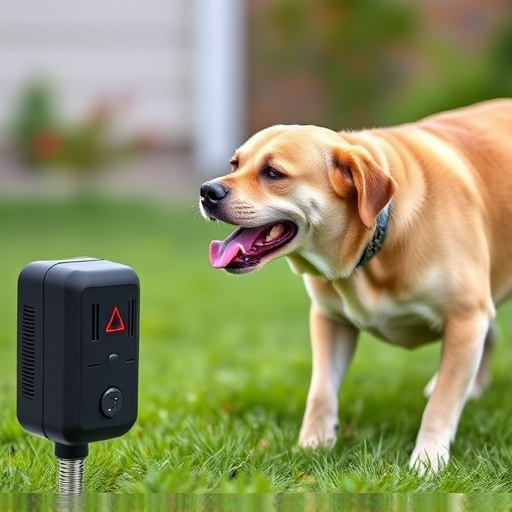Dog barking can disrupt community harmony, but understanding canine communication and strategically placing ultrasonic repeller devices near frequent bark hotspots like fences or patios can effectively deter excessive barking without causing harm. These devices use inaudible high-frequency sound waves to create an unpleasant sensation when dogs bark, fostering a quieter environment for everyone. Regular training with positive reinforcement techniques is crucial for long-term success, emphasizing commands like "quiet" or "sit" to help dogs associate the ultrasonic sound with controlling their barking.
In many neighborhoods, dog barking can be a persistent and disturbing issue, straining relationships between neighbors. This article explores effective solutions, focusing on anti-barking devices, particularly ultrasonic repellers. We delve into the science behind these tools, how they work to deter excessive barking, and provide strategic tips on the best placement for optimal results. Additionally, we offer valuable insights on combining these devices with dog training techniques for a comprehensive approach to creating a peaceful, harmonious community.
- Understanding Dog Barking and Its Impact on Neighborhoods
- How Ultrasonic Repeller Devices Work to Stop Barking
- Best Placement Strategies for Effective Use of Anti-Barking Devices
- Considerations and Tips for Training Dogs alongside Repeller Devices
Understanding Dog Barking and Its Impact on Neighborhoods
Dog barking is a natural form of communication for canines, but it can become a significant issue in neighborhoods when it disrupts peace and harmony. Understanding why dogs bark and how to address excessive barking is essential for fostering a peaceful living environment. In many cases, dogs bark due to fear, anxiety, boredom, or as a response to external stimuli like other animals or loud noises. Identifying the root cause of barking behavior is crucial in finding an effective solution.
When considering anti-barking devices, such as ultrasonic repeller devices, the best placement is strategic. These devices emit high-frequency sound waves that are unpleasant for dogs but generally harmless to humans and other pets. They should be positioned near areas where barking occurs frequently, like fences or patios. Additionally, ensuring these devices are away from windows and doors can prevent unwanted attention from passing pedestrians while still offering a deterrent for neighborhood dogs.
How Ultrasonic Repeller Devices Work to Stop Barking
Ultrasonic repeller devices use sound waves to stop barking in dogs, a method that’s both safe and effective. These devices emit high-frequency sounds, typically above 25 kHz, which are inaudible to humans but can be heard by dogs. When a dog barks, the ultrasonic waves activate, creating an unpleasant sensation for the animal without causing any physical harm. This discourages barking as the dog associates it with an aversive stimulus.
The best placement for these devices is usually outdoors, near where the barking occurs most frequently. Strategically positioning them in areas dogs frequent, such as yards or patios, can help prevent unwanted barking. Additionally, using multiple devices throughout the neighborhood can create a barrier of protection, reducing the likelihood of barking triggers and promoting a quieter environment for everyone.
Best Placement Strategies for Effective Use of Anti-Barking Devices
To ensure maximum effectiveness, anti-barking devices like ultrasonic repeller devices should be strategically placed in areas commonly frequented by neighborhood dogs. Best placement for these devices often involves positioning them near potential triggers, such as windows or fences where dogs frequently bark at passersby or other animals. Mounting them on walls or posts can help maintain a consistent frequency range to deter barking.
Additionally, consider the device’s sensitivity and range when selecting locations. Place them in spots that capture the attention of barking dogs without causing distress to nearby humans or pets. Regularly moving the devices between different strategic points within the neighborhood can also enhance their overall effectiveness by preventing dogs from becoming accustomed to a single location.
Considerations and Tips for Training Dogs alongside Repeller Devices
When implementing an anti-barking device, such as an ultrasonic repeller, proper training is key to long-term success. The first step is to understand that these devices are most effective when used alongside positive reinforcement techniques. Trainers should focus on teaching dogs alternative behaviors and reinforcing them with treats or praise when they display desired actions, like remaining quiet upon command. This method not only trains the dog but also strengthens the bond between owner and pet.
The best placement for ultrasonic repellers is in areas where barking occurs most frequently, such as near entry points or on patios. However, it’s important to remember that these devices work best when paired with consistent training. Regular practice of commands like “quiet” or “sit” can help dogs associate the ultrasonic sound with learning to control their barking. Additionally, ensuring proper fit and adjusting the device according to manufacturer guidelines is crucial for effectiveness and safety.
In addressing the concerns raised by excessive dog barking in neighborhoods, ultrasonic repeller devices offer a humane and effective solution. By understanding both the behavior behind barking and the precise functioning of these devices, residents can strategically place them to disrupt problematic barking without causing harm. However, true success lies in combining these tools with positive dog training methods. With patience and persistence, dog owners can train their pets to respond well to the ultrasonic signals, fostering a quieter and more harmonious environment for everyone. When used appropriately, the best placement for ultrasonic repeller devices, coupled with responsible training, can significantly mitigate barking-related issues within communities.
